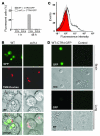Role of a CUF1/CTR4 copper regulatory axis in the virulence of Cryptococcus neoformans
- PMID: 17290306
- PMCID: PMC1784002
- DOI: 10.1172/JCI30006
Role of a CUF1/CTR4 copper regulatory axis in the virulence of Cryptococcus neoformans
Abstract
The study of regulatory networks in human pathogens such as Cryptococcus neoformans provides insights into host-pathogen interactions that may allow for correlation of gene expression patterns with clinical outcomes. In the present study, deletion of the cryptococcal copper-dependent transcription factor 1 (Cuf1) led to defects in growth and virulence factor expression in low copper conditions. In mouse models, cuf1Delta strains exhibited reduced dissemination to the brain, but no change in lung growth, suggesting copper is limiting in neurologic infections. To examine this further, a biologic probe of available copper was constructed using the cryptococcal CUF1-dependent copper transporter, CTR4. Fungal cells demonstrated high CTR4 expression levels after phagocytosis by macrophage-like J774.16 cells and during infection of mouse brains, but not lungs, consistent with limited copper availability during neurologic infection. This was extended to human brain infections by demonstrating CTR4 expression during C. neoformans infection of an AIDS patient. Moreover, high CTR4 expression by cryptococcal strains from 24 solid organ transplant patients was associated with dissemination to the CNS. Our results suggest that copper acquisition plays a central role in fungal pathogenesis during neurologic infection and that measurement of stable traits such as CTR4 expression may be useful for risk stratification of individuals with cryptococcosis.
Figures






Similar articles
-
Role of CTR4 in the Virulence of Cryptococcus neoformans.mBio. 2012 Oct 2;3(5):e00285-12. doi: 10.1128/mBio.00285-12. Print 2012. mBio. 2012. PMID: 23033470 Free PMC article.
-
Effects of CTR4 deletion on virulence and stress response in Cryptococcus neoformans.Antonie Van Leeuwenhoek. 2016 Aug;109(8):1081-90. doi: 10.1007/s10482-016-0709-2. Epub 2016 Jun 18. Antonie Van Leeuwenhoek. 2016. PMID: 27317510
-
Reciprocal functions of Cryptococcus neoformans copper homeostasis machinery during pulmonary infection and meningoencephalitis.Nat Commun. 2014 Nov 24;5:5550. doi: 10.1038/ncomms6550. Nat Commun. 2014. PMID: 25417972
-
Cryptococcus neoformans: a sugar-coated killer with designer genes.FEMS Immunol Med Microbiol. 2005 Sep 1;45(3):395-404. doi: 10.1016/j.femsim.2005.06.005. FEMS Immunol Med Microbiol. 2005. PMID: 16055314 Review.
-
Iron and fungal pathogenesis: a case study with Cryptococcus neoformans.Cell Microbiol. 2008 Feb;10(2):277-84. doi: 10.1111/j.1462-5822.2007.01077.x. Epub 2007 Nov 27. Cell Microbiol. 2008. PMID: 18042257 Review.
Cited by
-
Copper Metabolism in Naegleria gruberi and Its Deadly Relative Naegleria fowleri.Front Cell Dev Biol. 2022 Apr 11;10:853463. doi: 10.3389/fcell.2022.853463. eCollection 2022. Front Cell Dev Biol. 2022. PMID: 35478954 Free PMC article.
-
The Combination of Iron and Copper Increases Pathogenicity and Induces Proteins Related to the Main Virulence Factors in Clinical Isolates of Cryptococcus neoformans var. grubii.J Fungi (Basel). 2022 Jan 6;8(1):57. doi: 10.3390/jof8010057. J Fungi (Basel). 2022. PMID: 35049997 Free PMC article.
-
PI3K signaling of autophagy is required for starvation tolerance and virulenceof Cryptococcus neoformans.J Clin Invest. 2008 Mar;118(3):1186-97. doi: 10.1172/JCI32053. J Clin Invest. 2008. PMID: 18259613 Free PMC article.
-
The Yin and Yang of copper during infection.J Biol Inorg Chem. 2016 Apr;21(2):137-44. doi: 10.1007/s00775-016-1335-1. Epub 2016 Jan 20. J Biol Inorg Chem. 2016. PMID: 26790881 Free PMC article. Review.
-
The roles of zinc and copper sensing in fungal pathogenesis.Curr Opin Microbiol. 2016 Aug;32:128-134. doi: 10.1016/j.mib.2016.05.013. Epub 2016 Jun 18. Curr Opin Microbiol. 2016. PMID: 27327380 Free PMC article. Review.
References
-
- Casadevall, A., and Perfect, J. 1998. Cryptococcus neoformans. ASM Press. Washington, DC, USA. 541 pp.
-
- Saag M.S., et al. Practice guidelines for the management of cryptococcal disease. Infectious Diseases Society of America. Clin. Infect. Dis. 2000;30:710–718. - PubMed
-
- Jean S.S., et al. Cryptococcaemia: clinical features and prognostic factors. QJM. 2002;95:511–518. - PubMed
-
- Vilchez R.A., et al. The clinical epidemiology of pulmonary cryptococcosis in non-AIDS patients at a tertiary care medical center. Medicine (Baltimore). 2001;80:308–312. - PubMed
-
- Pagano L., Caira M., Fianchi L. Pulmonary fungal infection with yeasts and pneumocystis in patients with hematological malignancy. Ann. Med. 2005;37:259–269. - PubMed
Publication types
MeSH terms
Substances
Grants and funding
LinkOut - more resources
Full Text Sources
Other Literature Sources

